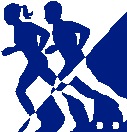
Rationale
The content analysis portion of this unit is based on the framework for the TGfU model of Griffin, Mitchell and Oslin (1997) and Hopper (2003). In order to determine the necessary movements and skills for students to gain an understanding of volleyball we drew from the two games framework questions they presented:
“What are the problems in scoring, preventing scoring, and restarting play?
What off-the-ball movements and on-the-ball skills are necessary to solve these problems?” (p. 10).
In order for students to gain tactical awareness in volleyball they must be engaged in games that have problems in those three areas and use both off-the-ball movement and on-the-ball skills within the games. The games designed in this unit cause students to engage with the activity further than just through the execution of simple motor skills.
Due to the time constraints of this unit and the entry abilities of the students, this unit also drew heavily on the Command (A) and Practice (B) styles of teaching (Mosston, 1992). These styles provide students with a large amount of practice time for each on-the-ball skill, without the tactical dynamic of the TGfU model. Students were then able to work on skills such as the forearm and overhead pass in a closed environment, until they had enough understanding of the necessary movements to apply the skill to a game situation.
Content Analysis

Tactical Problem
Scoring
-
•Forcing opponent to space
-
•Ball control
-
•Accuracy of passes
-
•Return over the net, in bounds
-
•Type of return
Preventing Scoring
-
•Reading opponent
-
•Defending space
-
•Choice of skill (forearm pass, overhead pass)
Restarting Play
-
•Accuracy of serve
Over the net
In bounds
-
•Positioning of the serve
Scoring
-
•Sending, receiving: Forearm or overhead pass, height, direction
Preventing Scoring
-
•Receiving: Forearm or overhead pass
Restarting Play
-
•Sending: Overhand or underhand serve, height, direction


Behavior Objectives
Based on the BC IRP other content of the unit includes the Personal and Social Responsibility curriculum organizer. For grade eight students the following content will be developed throughout the course:
Behavior Objectives
Students will be able to select and apply rules, routines, and procedures of safety in a variety of activities.
Students will be able to demonstrate self-confidence while participating in physical activity.
Students will be able to demonstrate appropriate social behavior while working cooperatively in group activities.
Students will be able to demonstrate etiquette and fair play.
Tasks in the unit
Students will be told the behavioral requirements of the unit prior to it beginning, will know what behavior is expected of them throughout the unit and potential consequences if they do not meet those requirements.
Games are designed so that students will be given a large amount of class time to participate and work with a variety of partners. Students will be expected to play competitively and to the best of their ability with any teammate or opponent.
Students will be required to participate in group and team play and will be expected to cooperate and communicate effectively in this setting.
When working with their peers, students must be polite and respectful of their peers regardless of their ability or relationship outside of the classroom. Students will be expected to demonstrate these principles during the activities and game play in the class.

Grade 8 Physical Education IRPs


